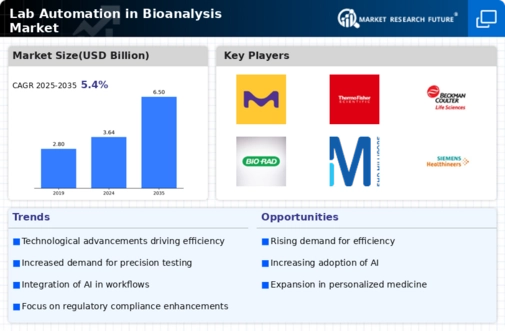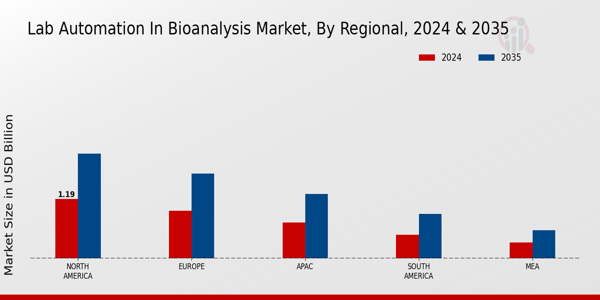Market Growth Projections
The Global Lab Automation in Bioanalysis Market Industry is poised for substantial growth, with projections indicating an increase from 3.64 USD Billion in 2024 to 6.5 USD Billion by 2035. This growth trajectory reflects a compound annual growth rate (CAGR) of 5.41% from 2025 to 2035. Various factors, including technological advancements, increased demand for high-throughput screening, and a focus on personalized medicine, are contributing to this upward trend. As laboratories continue to embrace automation, the market is likely to evolve, adapting to the changing needs of the bioanalytical landscape.
Technological Advancements
The Global Lab Automation in Bioanalysis Market Industry is experiencing rapid technological advancements that enhance laboratory efficiency and accuracy. Innovations such as robotics, artificial intelligence, and machine learning are streamlining workflows and reducing human error. For instance, automated liquid handling systems are now capable of performing complex assays with minimal human intervention, which significantly increases throughput. As a result, the market is projected to grow from 3.64 USD Billion in 2024 to an estimated 6.5 USD Billion by 2035, reflecting a compound annual growth rate (CAGR) of 5.41% from 2025 to 2035.
Rising Focus on Personalized Medicine
The shift towards personalized medicine is significantly influencing the Global Lab Automation in Bioanalysis Market Industry. As healthcare moves towards tailored treatments based on individual genetic profiles, laboratories require advanced automation solutions to analyze complex biological samples efficiently. Automated systems enable the rapid processing of large datasets, which is essential for the development of personalized therapies. This trend is expected to contribute to the market's growth trajectory, as the demand for sophisticated bioanalytical techniques increases in line with the evolving landscape of personalized healthcare.
Regulatory Compliance and Quality Assurance
Regulatory compliance and quality assurance are paramount in the Global Lab Automation in Bioanalysis Market Industry. Laboratories must adhere to stringent regulations set by agencies such as the FDA and EMA, which necessitate the implementation of automated systems to ensure consistent quality and traceability of results. Automation facilitates the documentation and validation processes required for compliance, thereby reducing the risk of human error. This focus on regulatory adherence is likely to drive market growth, as laboratories invest in automation technologies to meet these standards and maintain competitive advantages.
Global Health Initiatives and Research Funding
Global health initiatives and increased research funding are pivotal drivers for the Global Lab Automation in Bioanalysis Market Industry. Governments and organizations are investing in research to address pressing health challenges, which often necessitates advanced laboratory automation. For example, initiatives aimed at combating diseases such as cancer and infectious diseases require high-throughput bioanalytical capabilities. This influx of funding is likely to spur the adoption of automation technologies in laboratories, further propelling market growth as research institutions seek to enhance their operational efficiency.
Increased Demand for High-Throughput Screening
The demand for high-throughput screening (HTS) in drug discovery and development is a key driver for the Global Lab Automation in Bioanalysis Market Industry. HTS allows researchers to conduct thousands of tests simultaneously, accelerating the identification of potential drug candidates. This efficiency is crucial in the pharmaceutical sector, where time-to-market can significantly impact profitability. As pharmaceutical companies increasingly adopt automated systems to enhance their HTS capabilities, the market is expected to expand, aligning with the projected growth from 3.64 USD Billion in 2024 to 6.5 USD Billion by 2035.




















Leave a Comment